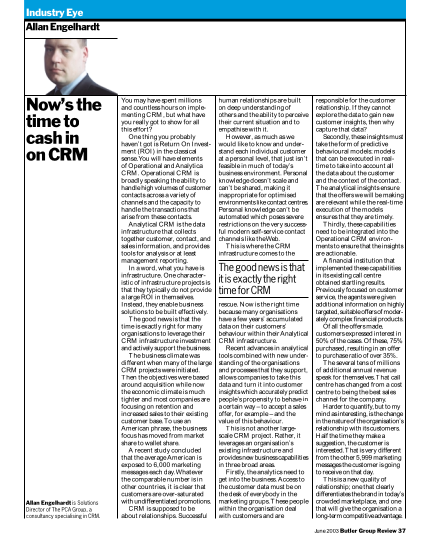I wrote a small (800 words) article (PDF) for one of the industry analyst’s publications on why it is the right time to finally get some real return on all those CRM (Customer Relationship Management) investments. Return in terms of money, for sure, but also in terms of a much higher quality of customer relationship.
CRM has been an abused term. Historically, i.e. up to circa now, it has been much more about efficiency than relationships. It has been about call centers which are all about economies of scale and operational efficiencies like screen pop and those dreaded IVR scripts (“Press 1 to go to Hell, 2 for Hades, and 3 for an loop of prompts with no hope of exit”). It has been about self-service: those IVRs again, but also the web, kiosks, and other channels; but self-service mainly as a way for the company to save costs (and employees).
In a word, CRM was about infrastructure. Infrastructure to handle contacts across multiple channels (telephone, e-mail, web, …), infrastructure to handle the resulting transactions (orders, trouble tickets, …), and infrastructure to handle all the resulting data and maybe produce a few reports.
Guess what: infrastructure projects do not, as a rule, produce any significant return on investment. (Not even (or: especially not) infrastructure projects costing several tens of millions of dollars and taking 2, 3, 4 or more years to implement.) Rather, they enable applications to be built cheaper, faster, more efficiently. These applications are then what directly benefits the business.
What has changed?
The good news is that the time is exactly right for many organisations to leverage their CRM infrastructure investment and actively support the business.
Three things have changed.
The economy. The business climate was different when many of the large CRM projects were initiated. Then the objectives were based around acquisition while now the economic climate is much tighter and most companies are focusing on retention and increased sales to their existing customer base. To use an American phrase, the business focus has moved from market share to wallet share.
Data availability. The history of CRM is such that many organisations have a few years’ accumulated data on their customers’ behaviour within their CRM data infrastructure. Briefly, many organizations implemented operations CRM systems in the mid-90ies and started to look at data infrastructure—data warehouses and analytical tools—around 1999-2000 which means that they probably went live sometime around 2000-2002. These organizations, the early adapters if you like, now have 2-3 years data available for analysis, which is for many businesses and for many behavior patters a useful time frame.
Tools and processes. Recent advances in analytical tools combined with new understanding of the organisations and processes that they support, allows companies to take this data and turn it into customer insights which accurately predict people’s propensity to behave in a certain way - to accept a sales offer, for example - and the value of this behaviour.
Results
A recent study concluded that the average American is exposed to 6,000 marketing messages each day. Whatever the comparable number is in other countries, it is clear that customers are over-saturated with undifferentiated promotions.
A financial institution that implemented the capabilities we have outlined here into its existing call centre obtained startling results. Previously focused on customer service, the agents were given additional information on highly targeted,suitable offers of moderately complex financial products.
Of all the offers made, customers expressed interest in 50% of the cases. Of these, 75% purchased, resulting in an offer to purchase ratio of over 35%.
The several tens of millions of additional annual revenue speak for themselves.That call centre has changed from a cost centre to being the best sales channel for the company.
Harder to quantify,but to my mind as interesting,is the change in the nature of the organisation’s relationship with its customers. Half the time they make a suggestion, the customer is interested.That is very different from the other 5,999 marketing messages the customer is going to receive on that day.
This is a new quality of relationship; one that clearly differentiates the brand in today’s crowded marketplace, and one that will give the organisation a long-term competitive advantage.
Links
- Download the article as PDF: Now’s the time to cash in on CRM
